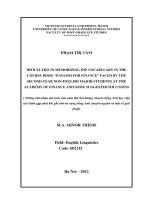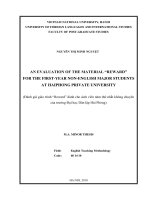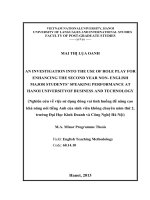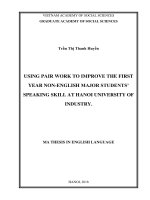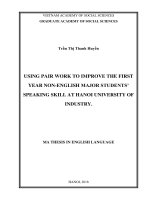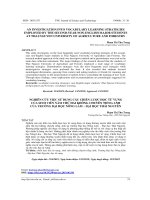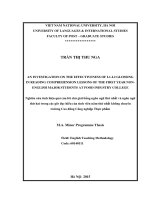AN INVESTIGATION INTO THE USE OF ROLE PLAY FOR ENHANCING THE SECOND YEAR NON- ENGLISH MAJOR STUDENTS’ SPEAKING PERFORMANCE AT HANOI UNIVERSITYOF BUSINESS AND TECHNOLOGY Nghiên cứu về việc sử dụng đóng vai tình huống để nâng cao khả năng nói tiếng Anh của
Bạn đang xem bản rút gọn của tài liệu. Xem và tải ngay bản đầy đủ của tài liệu tại đây (1.45 MB, 84 trang )
VIETNAM NATIONALUNIVERSITY, HANOI
UNIVERSITY OF LANGUAGES AND INTERNATIONAL STUDIES
FACULTY OF POST-GRADUATE STUDIES
MAI THI
̣
LU
̣
A OANH
AN INVESTIGATION INTO THE USE OF ROLE PLAY FOR
ENHANCING THE SECOND YEAR NON- ENGLISH
MAJOR STUDENTS’ SPEAKING PERFORMANCE AT
HANOI UNIVERSITYOF BUSINESS AND TECHNOLOGY
(
Nghiên cứu về việc sử dụng đóng vai tình huống để nâng cao
khả năng nói tiếng Anh của sinh viên không chuyên năm thứ 2,
trường Đại Học Kinh Doanh và Công Nghệ Hà Nội
)
M.A. Minor Programme Thesis
Field:
English Teaching Methodology
Code:
60.14.10
Hanoi, 2013
VIETNAMNATIONALUNIVERSITY, HANOI
UNIVERSITY OF LANGUAGES AND INTERNATIONAL STUDIES
FACULTY OF POST-GRADUATE STUDIES
MAI THI
̣
LU
̣
A OANH
AN INVESTIGATION INTO THE USE OF ROLE PLAY FOR
ENHANCING THE SECOND YEAR NON- ENGLISH
MAJOR STUDENTS’ SPEAKING PERFORMANCE AT
HANOI UNIVERSITYOF BUSINESS AND TECHNOLOGY
(
Nghiên cứu về việc sử dụng đóng vai tình huống để nâng cao
khả năng nói tiếng Anh của sinh viên không chuyên năm thứ 2,
trường Đại Học Kinh Doanh và Công Nghệ Hà Nội
)
M.A. Minor Programme Thesis
Field:
English Teaching Methodology
Code:
60.14.10
Supervisor:
Dr. Do Tuan Minh
Hanoi, 2013
i
DECLARATION
I certify that the minor thesis titled “An investigation into the use of role- play for
enhancing second year non- English major students’ speaking performance at
Hanoi University of Business and Technology”. is the result of my own work and
that this thesis has not been published or submitted for a degree to any other
universities or institutions.
Signature
Mai Thị Lụa Oanh
ii
ACKOWLEDGEMENTS
To complete the thesis, I have received a great deal of support from many people.
First of all, I would like to express my deepest gratitude to my supervisor Mr. Đỗ
Tuấn Minh for his scholarly knowledge, wholehearted supervision, insightful
guidance and constructive critical feedback. He has inspired and encouraged me
during the steps of the thesis.
Also, my special thanks are sent to my colleagues who helped me with useful
materials and classroom observations. My great thanks also go to my beloved
second-year students in two classes, KT1711 and KT1715, of Hanoi University of
Business and Technology (HUBT) for their participation in as well as their strong
support for the research with comments, classroom observation opportunities
without which my work would have not been completed.
Last but not least, I would like to convey my wholehearted thanks to my family and
all of my close friends for their encouragement and financial as well as spiritual
support for me to fulfill this thesis.
Hanoi, September 2013
Mai Thị Lụa Oanh
iii
ABSTRACT
Role play is one of the teaching techniques which has been widely accepted and
used in English language classes for many years both in Vietnam and in many other
countries in the world. Because of the advantages of role play, the author of this
study attempted to apply role play activities in teaching speaking to 60 second year
non- English major students in hope that role play can solve some of the students‟
speaking problems such as passive learning behaviors, boring and quiet atmosphere,
lack of motivation and confidence to speak, students‟ less speaking time, etc. This
action research is conducted in two classes of Accounting at Hanoi University of
Business and Technology with the focus on the effectiveness of role play in
enhancing students‟ speaking performance. In this paper, the author uses three
collection instruments: questionnaires, follow-up interviews with students and
observation in each speaking lessons through the evaluation sheets. The researcher
first reviews some theories regarding speaking skill, role play, and then analyzes the
participants‟ feedback and the teachers‟ observation on the effectiveness of role
play. The research shows that role play is an effective technique in changing the
students‟ attitudes towards speaking skill, their learning behaviors in speaking
lessons and enhancing the students‟ peaking performance.
iv
TABLE OF CONTENTS
PART A: INTRODUCTION 1
1. Rationale and statement of the problem for the study 1
2. Aims of the study 3
3. Scope of the study 4
4. Research questions and hypothesis 4
5. Method of the study 4
6. Organization of the study 5
PART B: DEVELOPMENT 6
CHAPTER 1: LITERATURE REVIEW 6
1.1. Theoretical background of speaking and teaching speaking 6
1.1.1. Definition and Nature of speaking 6
1.1.2. Successful speaking activity 6
1.1.3. Teaching speaking 7
1.1.4. Activities to promote speaking. 8
1.2. Theoretical background of role play technique 9
1.2.1. Definition of role play 9
1.2.2. Types of role play and procedures in using role play 10
1.2.3. Benefits of role play in teaching speaking 12
1.2.4. The teacher’s roles in role play activities 12
1.2.5. The learners’ roles in role play activities 14
1.3. Review of previous studies 15
CHAPTER 2: RESEARCH METHODOLOGY 17
2.1. Background of the study 17
2.1.1. The teaching and learning context. 17
2.1.2. The syllabus 17
2.1.3. The description of the teaching material 18
PART C: CONCLUSION 54
v
LIST OF ABBREVIATIONS
HUBT: Hanoi University of Business and Technology
ESL/ EFL: English as a second or foreign language
LIST OF TABLES
Table 1: Students‟ learning habits in previous speaking
Table 2: Students‟ knowledge about role play
Table 3: Students‟ interest in learning if role play is applied in speaking lessons.
Table 4: Students‟ comments on the teacher‟s instructions for role play.
Table 5: Students‟ preference for choosing pairs or groups
Table 6: Students‟ preference in being prepared for a role play
Table 7: Results of students‟ speaking performance in cycle 1
Table 8: Results of students‟ speaking performance in cycle 2
vi
LIST OF FIGURES
Figure 1: Students‟ knowledge about role play
Figure 2: Students‟ knowledge about what students do in role plays
Figure 3: Students‟ attitudes towards speaking lessons
Figure 4: Students‟ attitudes towards the role plays applied in the speaking lessons
Figure 5: Students‟ habit of waiting for their teacher‟s calling
Figure 6: Students‟ speaking time in role plays
Figure 7: Students‟ understanding of teacher‟s instruction for role plays
Figure 8: Students‟ actions when they do not understand the teacher‟s instructions
Figure 9: Students‟ learning behaviors when being asked to role play
Figure 10: Students‟ use of language in role plays
Figure 11: Students‟ difficulties in role plays
Figure 12: Students‟ comments on role plays organized by the teacher
Figure 13: Students‟ comments on the effectiveness of role play
Figure 14: Ways in which role play motivates students to speak
Figure 15: Students‟ reflection on their speaking ability after role play is applied
Figure 16: Students‟ improvement when role play is used in speaking lessons
Figure 17: Students‟ expectations to use role play in the next speaking lessons
Figure 18: The improvement in the students‟ speaking skill through role play
activities
1
PART A: INTRODUCTION
1. Rationale and statement of the problem for the study
In the age of globalization in many aspects of daily life, English is assumed not only
as a tool for international communication but also a powerful instrument to link
people from many countries all over the world. For this fact, the demand for
teaching and learning English in non- native English speaking countries is
increasing, and this is also not an except in Vietnam setting.
Of all the four English skills, speaking seems, according to O‟Malley and Pierce
(1996), to be an important skill that a learner should acquire. In addition, as stated
by Burn and Joyce (1997), one of the aims of most language programs is to develop
spoken language skills and learning a language means one can use it in
communication in oral or written forms to express feelings, thoughts and experience
in different contexts. However, regarding the context of Vietnam, speaking is
mostly considered to be a difficult one to master by many Vietnamese students.
From my own teaching experience and my class observation, many problems occur
during the process of teaching and learning speaking skill among my students and
other teachers at HUBT. However, the researcher of this study only mentions the
three most outstanding problems that frequently arise during the process of learning
and teaching speaking skill. These problems are investigated in terms of the
students‟ low speaking ability, the students‟ low motivation in learning English, and
the teacher‟s monotonous and inappropriate teaching techniques. These problems
seem to be closely connected and interrelated.
Regarding the problem of students‟ low speaking ability, this is indicated through
the fact that students only use a few words and give short responses when they are
asked in English. Their overwhelming use of Vietnamese in English discussion is
also a result of their low speaking ability. This unsatisfactory proficiency of the
students‟ speaking is mainly due to the students‟ low motivation, high anxiety, and
their limited vocabulary and also because of teachers‟ inappropriate use of teaching
2
techniques. As a result, the students easily get bored and uninterested in learning
this skill. The reality also shows that when students are exposed to monotonous
instructional activities, they do not participate actively and efficiently. This is
specifically illustrated through the fact that students are unwilling to involve
themselves in the assigned activities, and students do not have equal opportunity to
participate in speaking group work. Besides, most of my students have wrong
assumptions of working in pairs or groups in speaking lessons. They mostly
perceive that speaking lessons is only the procedure of putting class members into
groups, then each one try to complete their task mainly individually and
competitively. Furthermore, many of them carry out the speaking tasks assigned by
their teacher by writing down their ideas and passively wait for the teacher‟s calling
for presentation. As a result, many of them do not have chances to practice the
language required, and after the lessons they do not remember anything related to
the speaking tasks. All of these factors lead to the bad result that a few weeks later
and before the speaking test, they gain nothing about the language use in a specific
situation and they cannot communicate in English in their real life if the real life
situations require them to use.
Therefore, theoretically it is impossible for the students to learn English with low
motivation to have good speaking ability if they are inactive during the instructional
process. Besides, the students with low motivation will be defensive to use their
English in oral communication if monotonous classroom does not stimulate them to
participate in classroom interaction. In practice, whether or not the students‟
speaking ability improves is greatly influenced by the intensity and frequency of
their participation in oral communication.
In short, it can be said that the root of the problems above is due to teachers‟ use of
inappropriate teaching technique. Hence, there needs to be an appropriate technique
to overcome the students‟ low speaking ability. It is the responsibility of teachers to
find out effective techniques for presenting the teaching materials in order to
stimulate the students‟ positive attitude towards the speaking class.
3
Of all the teaching techniques, role play seems to be one of the most interesting
ones for the students to involve themselves in speaking activities. As said by Burns
and Joice (1997), in role – playing technique, “the students act or pretend to be
someone else in the actual world situation that is brought into the classroom”. If this
technique is utilized, it will “encourage peer learning and sharing of responsibility
between the teacher and the learner in learning process”. Besides, they also stated
that, for the shy learners, “Role play helps them by providing a mask where learners
with difficulty in conversation are liberated”.
For the above mentioned reasons I decide to chose role play as one of the
techniques to apply in my own teaching in speaking lessons in the hope of creating
better study environment and opportunities for students to effectively join in
speaking lessons. After all, I take these speaking related issues into consideration
and conduct an action research named: “An investigation into the use of role- play
for enhancing second year non- English major students’ speaking performance
at Hanoi University of Business and Technology”.
2. Aims of the study
The study firstly aims at investigating the effectiveness of using role play as a
technique in teaching speaking to the second year students at Hanoi University of
Business and Technology. Basing on the research results, this study also provides
practical suggestions for better use of role play technique in teaching speaking.
Regarding theory, the study provides English language teachers with more
knowledge about role play technique in terms of its types and its advantages. The
study also suggests some ways to successfully exploit role play activities in the
stages of teaching speaking.
In terms of pedagogy, the results of this study are believed to be relevant to
improving the teaching of oral skill to students at HUBT. Specifically, the study
may help teachers to create a more active and relaxing atmosphere for effective
4
speaking practice so that they can help their students to be better at this oral skill as
well as other language skills.
3. Scope of the study
In terms of language skills and participants, the author of this study only focused on
speaking skill. Apart from the first speaking lesson, the five other ones were
observed. Regarding types of role play, this study investigates the use of unscripted
role play in speaking lessons. The speaking lessons were carried out with the use of
role play in the Case Study section of the current course book which is implemented
at HUBT for two classes of the second-year non-English major students in the first
semester (school year 2013-2014).
4. Research questions and hypothesis
The study aims to investigate whether role play is a technique to motivate students
to participate in speaking activities and to improve HUBT students‟ speaking skill.
Therefore, the hypothesis for this study is that role play can be used as a technique
to enhance HUBT students‟ speaking performance. The following research
questions are given out to test the hypothesis:
1. How do the students learn speaking with role- play activities?
2. To what extent do role play activities help to improve the students‟ speaking
performance?
5. Method of the study
The research is conducted basing on both quantitative and qualitative data.
First of all, quantitative research approach was used to investigate the students‟
speaking performance and their participation during speaking lessons using role
play activities. The collected data will go through analysis and yield conclusion
about the subjects of the study. Besides, in each speaking lesson, students‟ learning
and their performance is observed directly by the researcher and the Vice Dean of
the English Faculty I who has much experience in English teaching and many
5
qualified English degrees. The observation by the third party to make the data
collected more objective and reliable. The checklists and field notes are carefully
noted down to record what really happens in speaking classes. The observation
forms are adapted from the frame of Harris‟oral speaking scale.
Additionally, questionnaires to investigate students‟ attitudes towards speaking
lessons, their learning habits and their opinions on the effects of using role play on
their involvement and speaking performance in speaking lessons. Closed and open-
ended questions, and rating scales responses are used to help the researcher have
detailed data.
Besides, qualitative approach is also employed in this study to collect data. The
students‟ ideas in the semi- structured interviews with teacher (face- to- face and
online chatting) make great contribution to the data analysis. Classroom recording is
also utilized and then transcript to make the data more reliable. The researcher can
process all the data to draw conclusions to the research question that to what extent
role play can help students enhance their speaking performance.
6. Organization of the study
This study is written in three main parts which are Introduction, Development and
Conclusion. The first part, Introduction, briefly gives general background
information of the study such as the rationale and statement of the problem for the
study, the aims and significance, scope, research questions and the method used to
carry out this study. The second part of this thesis is Development, which includes
three chapters. Chapter one provides the literature review which is relevant to the
study on major issues such as role play technique and speaking skill. Then some key
information about the teaching practice at HUBT, the participants, data collection
instruments, methods of data analysis and procedure of the study are presented in
Chapter two. The last chapter, Chapter Three, describes the analysis of a range of
data, and discusses and interprets the findings of the study. Finally, the Conclusion
discusses conclusions drawn from the study, comments on the limitations of this
research and makes some recommendations for further studies as well as the author‟s
professional development after the research.
6
PART B: DEVELOPMENT
CHAPTER 1: LITERATURE REVIEW
The study bases on theoretical background of speaking and role play technique.
This chapter reviews relevant literature and provides key information of the current
research findings to see how the research contributes to the field.
1.1. Theoretical background of speaking and teaching speaking
1.1.1. Definition and Nature of speaking
As defined in Oxford Advanced Dictionary, speaking is the one‟s ability to express or
communicate opinions, feelings or ideas, etc or according to Chaney, speaking is “the
process of building and sharing meaning through the use of verbal and non-verbal
symbols in a variety of contexts”.
To put it another way, Brown (2001) stated, speaking is an interactive process of
meaning construction which involves producing and processing information. Speaking
is also a process whose form and meaning are dependent on the context in which it
occurs and is usually used as a means of communication in daily interaction. In
speaking activity, it is a must for the speaker and the listener to build up a mutual
communication. Therefore, speaking is inseparable from communication because
communication is also the way one can show feelings, thoughts, ask questions, ask for
help, persuade…
In regards to the nature of speaking, Bygate (1987) discusses speaking involves micro-
linguistics skills which are necessarily required to understand grammar, vocabulary,
and the rules of word order in sentence building.
1.1.2. Successful speaking activity
According to Ur (1996) there are four main characteristics which make up a successful
speaking activity. These characteristics include: learners‟ talking, even participation
among learners, high motivation and acceptable language use. These characteristics
seem only to be able to be achieved in English classes which employ the
7
Communicative Language Teaching and Learning approach. In these classes, students
involve much more and actively in the speaking lessons. They also should try their best
to talk as much as they can, and they can have opportunities to raise their voices and
express themselves in comprehensible ways with acceptable level of accuracy.
However, the most important thing in speaking lessons is that during and after the
speaking lessons, only can students communicate in reality, those speaking lessons
can be considered to be successful. To set the conditions for developing students‟
speaking ability, Pattison (1992) emphasizes on four main factors which are
followed:
- Learners choose what they want to say by giving them a list of different situations
or topics (with one or some grammar points for elementary level).
- Type of drills in which learners respond mechanically without thinking about what
they are saying is left out.
- Teachers should pay more attention to fluency than accuracy and do not interrupt
to correct mistakes or errors.
- Pair or group work is employed.
The above mentioned factors are most likely to be achieved when the speaking
lessons are implemented with role play activities.
1.1.3. Teaching speaking
According to Nunan (2003), teaching speaking is to teach language learners to
“produce the English speech sounds and sounds pattern”, “use words and sentence
stress, intonation patterns and the rhythm of the second language” “select appropriate
words and sentences according to the proper social setting, audience, situation and
subject matter”. Nunan also stated that teaching speaking is teaching students to know
how to “organize their thoughts in a meaning and logical sequence”, to help students to
have ability to “use the language as a means of expressing values and judgments” and
8
to “use the language quickly and confidently with few unnatural pauses, which is called
fluency”.
Furthermore, as written in “Developing speaking skill in the young learners’
classroom” by Natasa, posted on the Internet TESL journal (Vol XII, No.11,
November 2006), some factors should be put into consideration when teaching
speaking. Those are considerations regarding a class mixed of varied abilities,
expectation, motivation level, knowledge and different learning styles. Another thing
that teachers should take into consideration when teaching is that interaction is
important in speaking practice. Therefore, students‟ speaking time should be increased
as much as possible. Communicative Language Teaching and Collaborative Learning
seem to serve best for this purpose because this teaching method provides students with
more opportunities to communicate with each other in the target language.
In short, teachers should provide favorable conditions for students by creating
classroom environment where students have real- life communication, authentic
activities and meaningful tasks that promote oral practice. These conditions are most
likely to be able to achieve when role play is used as one of the communicative
teaching techniques.
1.1.4. Activities to promote speaking.
There may be various types of activities used to promote speaking practice. However,
Hayriye Kayi mentions 13 activities in his article on TESL journal. These activities
includes discussions, role play, simulations, information gap, brainstorming,
storytelling, interviews, story completion, reporting, playing cards, picture narrating,
picture describing, and find the differences.
This study focuses on the use of role play as a teaching technique to promote speaking
practice. In this type of activities, according to Harmer (1984), students pretend they
are in different social contexts and have a variety of social roles. Also, in role play, the
teacher gives the learners information of who they are, and what they think they feel.
9
1.2. Theoretical background of role play technique
1.2.1. Definition of role play
As defined in Cambridge International Dictionary of English (Cambridge University
Press, 1996) by Paul Procter, role is “the person whom an actor represents in a film or a
play” and role play is “a method of acting out particular ways of behaving or
pretending to be other people who deal with new situations. It is used in training
courses, language learning and psychotherapy”.
According to Gillian Porter Ladousse, when students take up a “role”, they play a part
in specific situation, and “play” means “that is taken on in a safe environment in which
students are as an inventive and playful as possible”.
Besides, in defining role play, Donn Byrne comments that role play is a part of drama
activity. Particularly, drama activities consist of three terms which are “mime”, “role
play” and “simulation”. He describes “mime” as the action in which “the participants
who perform actions without using words”, “role play” as the activity in which
“participants interact either as themselves in imaginary situations”. ”Simulation is
described the same as role play but the participants in this activity usually discuss a
problem with some setting which has been defined for them. Therefore, according to
the definition by Donn Byrne, role play and simulation seem to be commonly used in
foreign language classes to encourage communicative competence, and mime is more
appropriately used as a language game in which one person performs actions and the
others guess.
From the definitions above, it can be put in short that role play is a popular technique
which utilizes one‟s imagination to be someone else or to be ourselves in a particular
situation for a while to carry out dialogues and to create a real world in the scenario.
The aim of role play is to encourage students‟ creative thinking, to let students practice
and develop the target language, and to create students‟ motivation and involvement
which are necessary for learning to occur.
10
1.2.2. Types of role play and procedures in using role play
Role play is one of the most popular communicative teaching techniques used in CLT
classroom. As cited by Donn Byrne (1990), it is classified into two types which are
scripted and non- scripted role plays.
Scripted role play:
To perform the scripted role play, students work in pairs or groups and they are given
prompts related to the scenario. Students will use the prompts as the model to perform
the target dialogue. Before performing in front of the class, students have time to
rehearse.
According to Donn Byrne, scripted role play involves the interpretation of the
dialogues or speech in textbooks. To demonstrate more specifically, Adrian Doff gave
an example of scripted role play dialogue and how the procedure is as follow:
Angela : Good morning. I want to send a letter to Singapore.
Clerk : Yes, do you want to send it by air mail or ordinary mail?
Angela : I think I’ll send it air mail. I want it to get there quickly. How
much does it cost?
Clerk : To Singapore? That will be 30 pence, pleas.
Angela : (give the clerk 50 pence) Here you are.
Clerk : Here is your stamp, and here is 20 pence change.
Angela : Thank you. Where is the post box?
Clerk : You want the air mail box. It is over there, by the door.
(Adapted from living English book 2 : A.G. Abdalla et al)
To encourage students to role play basing on the dialogue, Adrian Doff gives out the
procedure as follows:
11
Firstly, the teacher guide the activity by giving out some prompts like (where?/ air
mail/ how much?/post box/ thanks ). Teacher can also go through the prompts one by
one and asks students to give sentences or questions for each prompt. Next, teacher
calls 2 students, one play the role as Angela and the other is the post office clerk. At
this stage, teacher also points out to them that they are going to make a similar dialogue
which covers the main points indicated by the prompts. Then, teacher will call some
more pairs to make similar dialogues based on the prompts.
Non- scripted role play:
As for non- scripted role play, students are assigned to perform the role play activity in
front of the class basing on the prompts given without preparing or writing the script in
advance. This type of role play does not depend on textbook and students themselves
have to decide their language use decide how to develop the conversation. To do
activities of this type well, both teacher and students need to have good preparation.
The following example and procedures of unscripted role play are adapted from
Andrian Doff:
Situation: One student has lost a bag. He/ she is at the police station. The other student
is the police officer, and asks for details.
To develop the role play, teacher could prepare the class by discussing what the
speaker may say (For example, the police officer would ask the students how he or she
lost the bag ). The teacher can also guide the role play by writing prompts or any key
vocabulary on the board. Next, the teacher can divide the class into pairs and let them
discuss together what they may say and rehearse the role play before calling them to
present in front of the class.
The procedures for teaching role play activities can be varied for each teacher.
Therefore, teacher should be flexible to make it an appropriate and effective activity for
his or her students.
12
1.2.3. Benefits of role play in teaching speaking
As said above, role play is one of the activities to promote speaking among students.
According to Larsen Freeman (1997), role play is one of the important teaching
techniques in the communicative approach as it provides learners with opportunities to
practice communication in different social contexts and to take up different roles.
Besides, as stated by Ladousse, role play is a flexible learning activity which
encourages learners‟ imagination. Also, role play is a communicative technique which
improves students‟ fluency in language and promotes students‟ interaction. Another
advantage of role play which is also stated by Ladousse is that with role play, students
can experience different situation using the target language to practice. For shy
learners, role play provides them a “mask” to get on well with their peers to join in the
situation. Most importantly, role play increases motivation and makes language
learning fun and memorable to learners.
1.2.4. The teacher’s roles in role play activities
In regard of teacher‟s roles, Wright (1987) mentioned in his book that one of the main
roles of the teacher in role play is management function in which her task is to create
favorable conditions for role play to take place. Another teacher‟s role, according to
Wright, is the instructional function to the students. These two teacher‟s roles are put in
one term as “facilitator” by Littlewood (1981). Breen and Candlin (1980) add other
three teacher‟s roles which are to act as facilitator of the role play process and to act as
a participant, and to act as an observer and learner.
a. Facilitator.
As a facilitator, the teacher may need to perform a variety of specific tasks which are as
followed:
(1). The teacher may perform the role of language instructor. In this role, the teacher
may provide the students with learning materials and initiate role play activity.
(2). The teacher is the organizer of the classroom activities.
13
As stated by J. Harmer (1991), of all the roles, the teacher‟s role as organizer is the
most important and difficult from the classroom management perspective. In his view,
whether a role play activity is successful or not largely depends on the teacher‟s good
organization and on students who know exactly what they are going to do. When
organizing a role play activity, the teacher tells what they are to talk about, gives clear
instructions about what their role is, gets the role play activity going, and then
organizes feedback when it is over. As stated by J. Harmer, the carrying out of these
tasks sounds easy, but can be “disastrous” if teachers have not thought out exactly what
they are going to stay beforehand.
Beside theses, the teacher has to divide the whole class into pairs or small groups to
work. When the role play is conducted by the students, the teacher has to walk around
the classroom to make sure the communication is going smoothly.
(3). The teacher may be the error corrector.
Though before the performance of role play activity, errors should be strictly monitored
and corrected, at the group work and class work levels in conducting and presenting
role play, linguistic errors are viewed as unavoidable in communication and can be
ignored as long as communication is hindered by those errors.
(4) The teacher may choose to be a by- stander or passive viewer who has no
intervention after delivering the proceedings, and let communication take place through
independent activities.
(5). The teacher may act as a consultant or an adviser while role play is in progress.
With this role, the teacher walk around the classroom and help students if necessary
and if is asked. The students may have questions about the language items and the role
they choose or assigned. The teacher‟s help in this case may be an important support
for many students, especially for those who are slow to develop independence.
b. Participant
During the process of role play, teacher should also participate as an equal in the
activity. He can offer his information; stimulate the students and present new language
14
items without taking the main initiative role for communication away from the
students.
c. Observer and learner
Beside the above mentioned roles, teacher may also act as an observer and learner.
During the process of role play, teacher can move around the classroom and monitor
the strengths and weaknesses of the students for planning future learning activities.
From the students‟ weaknesses, he may address the later learning needs through more
controlled, pre- communicative activities.
In short, regarding the teacher‟s roles in role play activities in developing
communicative abilities among students, teacher is less dominant but important to
make the activity successful. He is a facilitator of the communicative process in which
he may play the roles of an instructor of language items, organizer of role play activity,
error corrector, passive viewer and consultant. He may also join in the role play
activities as co- communicator or observer.
1.2.5. The learners’ roles in role play activities
Since the application of Communicative Language Teaching Approach, the roles of
learners have changed. As stated by Morrow (1977): “the learner is now concerned
with using language, not English usage. In order to do this, learners take on roles and
interact with other learners who also have roles. What they say is determined by the
roles they play, their communicative intentions and the contribution of the other
learners”. Therefore, it is obviously inferred that the roles of learners in role play
activities are different from those found in the traditional classroom activities.
According to Breen and Candlin (1980), the learner acts as a negotiator between
himself, the learning process and the object of learning. This role interacts with the role
of joint negotiator within the group. In other words, the student should contribute as
much as he gains. This role is, according to Breen and Candlin, clarified by the
specific roles as followed:
15
- Learners regularly work in groups or pairs to transfer, negotiate meaning in situations
in which each person plays his own role.
- Learners often engage in role play or dramatization to adjust their use of the target
language to different social contexts.
- Learners are given some control; their creativity and innovation are encouraged.
To put it simply, it can be said that all of those roles help to improve learners‟ sense of
competence, self- worth, a sense of their learning and increase their intrinsic motivation
in learning the language.
1.3. Review of previous studies
There have been various studies on the exploitation of role play in English language
teaching and learning. In the research by D.Wilkin (1976), he emphasized the concept
of communicative approach in classroom teaching in which presentation, practices and
production stages are carried out by teacher and learners. In the third stage, Wilkin put
great emphasis on the use of role play as a technique in which learners imitated the
reality in the given context and situation. Also in D.Wilkin‟s research, he mentions the
procedure for organizing the role play practice. According to D.Wilkin, teacher should
provide students with a particular context and several roles to prepare and then perform
in front of the class. Several groups in the class can work to develop their performance.
While one pair or group is performing, the rest are students and discuss what the
group‟s strengths are and what the things they need improve afterwards are. Therefore,
according to D.Wilkin, the follow- up discussion is also a kind of practice. In D.Wilkin
study, he proves that role play is an effective technique to make a friendly teaching and
learning atmosphere, to arouse the learners‟ interests and to make the language
acquisition more impressive and memorable.
Besides, the author of the research titled “using role play in teaching speaking” (2007),
Ayu Diyah Harni Susanti from the State Islamic University proves the effectiveness of
role play in the ways that it provides the learners with real situations to practice the
target language, it encourages the learners‟ creativity, confidence to speak in front of
16
many people. More importantly, it enriches students‟ knowledge and skills needed in
social communication. Ayu carried out the study on tenth grade students from four
classes with the use of experimental research with results gained from the pre- test and
post test. The two speaking tests‟ aims are to assess the students‟ pronunciation,
fluency and speaking manner. After the time of treatment using role play in teaching
speaking, the post- test was carried out on the participants. Through data from the post-
test results, the interview and the recording, the author pointed out the advantages of
using role plays.
17
CHAPTER 2: RESEARCH METHODOLOGY
This chapter presents key information about the teaching practice at HUBT, the
participants, data collection instruments, methods of data analysis and procedure of
the study.
2.1. Background of the study
2.1.1. The teaching and learning context.
Hanoi University of Business and Technology (named Hanoi University of
Management and Business before May, 2006) was established in June, 1996, by
Professor Tran Phuong (Chairman of Economic Science of Vietnam, former Vice
Chairman of the Ministerial Council). As suggested by its name, such subjects as
accounting, finance, business administration, foreign trade, etc are the core ones in
the school‟s training program. Along with these majors, English is considered as an
essentially important subject because it serves as a means of international
communication and it is helpful to the students after graduations.
As the great emphasis is put on English, good conditions for English teaching and
learning have been provided. Overhead projectors, videos, cassette and CD players
are equipped so that teachers and students can carry out their teaching and learning.
English books, newspaper, magazines and computer with Internet access are always
available in the library of the school. However, students rarely have chances to
communicate with foreigners, especially English native speakers.
2.1.2. The syllabus
The ultimate objective of English teaching program at HUBT is to make students be
able to communicate with foreigners in written and spoken English at intermediate
level and pass the TOEIC tests at the end of the English course which stretches in
seven semesters. For those students who take up this course, English is not their
major but a compulsory subject in the courses. The training program is classified
into two categories according to the students‟ English proficiency because they had

